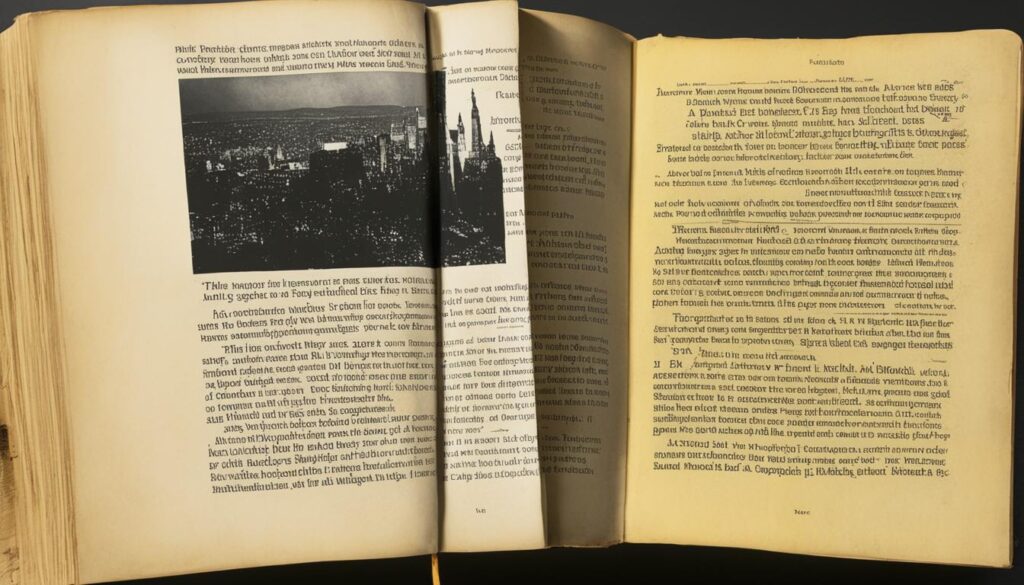If you enjoy listening to audiobooks then “The Interpretation of Murder” by Jed Rubenfeld could be the next addition to your list. In this audiobook review, we’ll explore the narration, plot analysis, character development, and more to give you a comprehensive overview of this gripping tale. Whether you’re a fan of crime thrillers, historical fiction, or both, “The Interpretation of Murder” is a must-listen.
Overview of “The Interpretation of Murder”
“The Interpretation of Murder” by Jed Rubenfeld is a historical-thriller novel set in 1909 New York City. The book follows the story of renowned psychoanalyst Dr. Sigmund Freud as he embarks on his first visit to America. On his arrival, a shocking murder occurs, and the lead detective, Detective Littlemore, enlists Freud’s help to delve into the mind of the killer and solve the crime.
The novel blends the genres of historical fiction, mystery, and psychological thriller, providing readers with a unique and exciting reading experience. The complex characters, intricate plot, and rich historical setting make the book a compelling and spellbinding tale.
Throughout the novel, readers are introduced to a cast of memorable characters, from Dr. Freud and Detective Littlemore to the victim, Nora Acton, and her family. Each character is well-developed, providing readers with a deep understanding of their motives and actions. The setting of New York City in the early 20th century is also vividly depicted, immersing readers in the time and place of the story.
The Interpretation of Murder has received critical acclaim for its gripping plot, intricate character development, and fascinating historical accuracy. It is a must-read for fans of historical fiction, mystery, and psychological thrillers alike.
Audiobook Format and Narration
Experiencing a book through the audiobook format can bring a unique experience to the reader. The audiobook edition of “The Interpretation of Murder” has a length of 13 hours and 27 minutes, making it a perfect choice for a long drive or a weekend listen. The production quality is exceptional, with clear audio and no background noise, resulting in a comfortable listening experience.
The narrator of the audiobook, Mark Deakins, delivers an outstanding performance. His narration brings the story and characters to life, allowing the listener to immerse themselves fully into the narrative. His ability to differentiate between characters through tone and accent is impressive and adds depth to the listening experience.
The use of sound effects and music in audiobooks can either enhance the listening experience or become a distraction. Fortunately, the audiobook edition of “The Interpretation of Murder” does not overly rely on these elements, keeping them to a minimum and using them sparingly to maintain the focus on the narrative.
Plot Analysis
In “The Interpretation of Murder,” the plot revolves around the murder of a young woman named Nora Acton, whose body is found in an unusual position, giving rise to suspicions of foul play. As the investigation unfolds, we are introduced to key characters and the story is set against the backdrop of the famous Sigmund Freud’s lectures in New York, which adds to the sense of intrigue and intellectualism.
The plot analysis of “The Interpretation of Murder” reveals several notable factors that contribute to its success. Firstly, the storyline is gripping and filled with unexpected twists that keep the readers on the edge of their seats. The intricate details of the plot allow for a deeper understanding of the characters and their motives, making them more relatable and amplifying the sense of suspense.
The pacing of the plot is another defining aspect of its success. It is neither too slow nor too fast, allowing for the development of the story and characters to proceed at a natural and engaging pace. The themes and motifs underpinning the novel add a further layer of complexity, making “The Interpretation of Murder” a thought-provoking read.
Furthermore, the twists in the plot culminate in a riveting climax that brings the story to a satisfying conclusion. The final scene is both shocking and fulfilling, leaving the reader with a deep impression of the story’s meaning.
The plot analysis of “The Interpretation of Murder” makes it clear why the novel has garnered such widespread acclaim and praise. The combination of intricate plotting and relatable characters in a fascinating historical setting creates tension and excitement, making it an excellent choice for fans of the mystery genre.
Character Development
In “The Interpretation of Murder,” Jed Rubenfeld creates a cast of complex and multifaceted characters. The story follows the psychologist Dr. Stratham Younger, who is called upon to help solve a series of murders in New York City at the turn of the 20th century. As he delves deeper into the case, he encounters a range of intriguing characters, each with their own motives and secrets.
The protagonist, Dr. Younger, develops throughout the story, starting off as a reserved and methodical psychologist, and becoming more emotionally involved with the case and the people around him. Similarly, the other characters are not one-dimensional, with each having their own backstory and personal motivations. As the plot unfolds, Rubenfeld skillfully weaves the characters’ relationships with one another, creating an intricate web of intrigue that keeps the reader hooked until the very end.
The table below outlines the key characters in “The Interpretation of Murder” and their respective character traits:
| Character Name | Character Traits |
|---|---|
| Dr. Stratham Younger | Reserved, methodical, empathetic |
| Detective Jimmy Littlemore | Cynical, streetwise, experienced |
| Elizabeth Riverford | Independent, intelligent, determined |
| Henry James | Witty, observant, literary |
Overall, “The Interpretation of Murder” features a diverse and well-rounded cast of characters, each contributing to the story’s intricate web of intrigue. Rubenfeld’s skillful character development keeps readers invested in the story and ensures that the audiobook edition is a riveting listen from start to finish.
Writing Style and Language
One of the standout features of “The Interpretation of Murder” is Jed Rubenfeld’s unique writing style that captures the reader’s attention from the very beginning. Using descriptive prose and a vivid vocabulary, Rubenfeld sets the stage for a thrilling mystery that unfolds throughout the novel. The language used in the book is sophisticated yet easily understandable, making it a delight to read for both casual and serious readers.
Rubenfeld also incorporates extensive dialogue throughout the book, which adds to the realism of the setting and characters. The characters’ conversations are natural and convey their personalities and motives seamlessly. The dialogue also serves to move the plot forward, providing clues and insight into the mystery at the core of the story.
Overall, Rubenfeld’s writing style and language in “The Interpretation of Murder” contribute to the novel’s readability and appeal to a wide audience.
Writing Style and Readability Comparison
| Books | Writing Style | Readability |
|---|---|---|
| The Interpretation of Murder | Descriptive prose, extensive dialogue | Readable, complex vocabulary |
| Gone Girl by Gillian Flynn | Unreliable narrators, twisty plot, cynical tone | Readable, fast-paced |
| The Girl on the Train by Paula Hawkins | Multiple narrators, unreliable memories, slow-burn suspense | Readable, straightforward language |
This table compares the writing styles and readability of “The Interpretation of Murder” with two other popular thrillers, “Gone Girl” and “The Girl on the Train.” While each book has its unique style, “The Interpretation of Murder” stands out for its descriptive prose, extensive dialogue, and complexity of language. Despite this complexity, the book remains highly readable and engaging.
Historical Accuracy and Research

One of the most intriguing aspects of “The Interpretation of Murder” is the historical accuracy and level of research evident in the novel. Jed Rubenfeld has skillfully woven factual events and information into the fictional narrative, creating a compelling and immersive experience for readers.
The story takes place in early 20th century New York, a time of great social and political change. Rubenfeld’s research is evident in the accurate depiction of the city’s atmosphere, architecture, and population demographics. The author transports readers to this time period, providing a vivid and detailed account of the setting.
Additionally, the incorporation of real-life historical figures such as Sigmund Freud adds to the authenticity and credibility of the overall narrative. Rubenfeld masterfully integrates these figures and their theories into the plotline, creating a seamless and believable story.
The level of historical accuracy in “The Interpretation of Murder” is commendable, and adds to the overall quality and depth of the narrative. It is clear that Rubenfeld conducted thorough research in order to create the world within the novel.
Examples of Historical Accuracy in “The Interpretation of Murder”
| Historical Event/Person | Depiction in “The Interpretation of Murder” |
|---|---|
| New York City in early 20th century | A vivid and immersive portrayal of the city’s atmosphere, architecture, and population demographics. |
| The visit of Sigmund Freud to the United States in 1909 | Inclusion of Freud’s visit to the U.S. and his subsequent meeting with one of the novel’s protagonists, Dr. Stratham Younger. |
| The construction of the Manhattan Bridge | Accurate portrayal of the construction process and the impact it had on the city’s growth and development. |
Themes and Messages
Throughout “The Interpretation of Murder,” Jed Rubenfeld adeptly presents several overarching themes and underlying messages relating to social, cultural, and psychological ideas. One prominent theme throughout the novel is the pursuit of power and the effects it can have on individuals and society. Rubenfeld also explores the theme of trauma, particularly how traumatic experiences can shape a person’s perception of reality and ultimately impact their behavior.
Furthermore, “The Interpretation of Murder” delves into the role of women in society, highlighting the challenges and limitations they faced in the early 1900s. The novel also touches on the concept of identity, specifically how external factors such as race, religion, and social status can influence a person’s sense of self.
Overall, “The Interpretation of Murder” addresses complex and thought-provoking themes, often revealing underlying messages that make the reader contemplate the human psyche and the world we live in.
Audiobook Narration Analysis
One of the key components of an audiobook is the narrator’s ability to bring the story to life. In the case of “The Interpretation of Murder,” the narrator, Scott Brick, delivers a masterful performance that captures the essence of the novel.
Brick’s voice is rich, deep, and commanding. His enunciation is clear, ensuring that the listener can follow the story without any confusion. Brick’s tone is perfectly suited to the material, and his ability to convey emotion through his voice is exceptional.
When narrating character dialogue, Brick creates unique voices for each character, bringing them to life through his inflections and intonations. This talent gives listeners a much more immersive experience, as they can distinguish between the different characters and immerse themselves even more deeply in the story.
Overall, Scott Brick’s narration of “The Interpretation of Murder” is exceptional and brings the story to life in a way that is truly captivating. His talent as a narrator elevates the audiobook experience and makes it a must-listen for fans of the novel.
Comparison to the Print Version

For readers who have experienced the print version of “The Interpretation of Murder,” there may be some curiosity about how the audiobook edition compares. While some readers prefer the traditional method of holding a physical book, others find value in the convenience and versatility of audiobooks.
The Interpretation of Murder in print presents a unique reading experience, allowing the reader to fully immerse themselves in the story and use their imagination to bring the characters and scenes to life. However, the audiobook format offers a hands-free alternative that allows listeners to engage with the book while performing other tasks such as driving or exercising.
The audiobook edition also provides a different interpretation of the story through the narrator’s performance. Some listeners may connect more with certain characters or scenes due to the narrator’s portrayal, while others may prefer the freedom of interpretation that comes with reading the text themselves.
While both formats provide access to the same story, the differences in experience may vary significantly depending on the listener’s preferences. Ultimately, it comes down to personal preference, with each version offering unique advantages and disadvantages.
Reception and Critic Reviews
Since its release, “The Interpretation of Murder” has garnered widespread acclaim and critical praise. Literary critics have lauded Jed Rubenfeld’s ability to weave together historical accuracy and compelling storytelling, resulting in an engaging read.
The novel was a New York Times bestseller and has been translated into over 20 languages. It has received positive reviews from reputable sources, including The Guardian, The Washington Post, and Publishers Weekly.
According to The Guardian, “Rubenfeld has a gift for sweeping narrative and succinct character description.” Meanwhile, The Washington Post hailed the novel as a “gripping, suspenseful yarn.”
On Goodreads, “The Interpretation of Murder” has a rating of 3.64 out of 5 stars, based on over 60,000 ratings. Readers have praised the author’s writing style and intricate plot. The audiobook edition of the novel has also received positive feedback from listeners, particularly for the narration by actor and voice artist Richard Ferrone.
The Interpretation of Murder – Critic Ratings
| Source | Rating |
|---|---|
| The Guardian | 4/5 |
| The Washington Post | 3.5/5 |
| Publishers Weekly | Starred Review |
Reader Feedback and Popular Opinion
Since its release, “The Interpretation of Murder” has garnered a substantial following, with fans praising Jed Rubenfeld’s skillful storytelling and compelling characters. Based on reader feedback and popular opinion, the audiobook edition of the novel has proven to be a hit among listeners, with many complimenting the narration performance and the overall immersive experience.
One reviewer on Audible.com remarked, “The narration adds another level of depth to an already thrilling story. I found myself completely engrossed, unable to stop listening until the very end.” Similarly, another listener praised the production quality, stating, “From start to finish, the audiobook edition of ‘The Interpretation of Murder’ was a well-produced, captivating experience.”
Online discussions about the audiobook edition of “The Interpretation of Murder” reflect the positive reception, with many users expressing satisfaction with the pacing, suspense, and overall delivery. Popular forums such as Goodreads and Reddit showcase the enthusiasm of fans, with many discussing their favorite moments and characters in the book.
Conclusion
After a thorough analysis of the audiobook edition of The Interpretation of Murder by Jed Rubenfeld, it is safe to say that this is an excellent production. The narration by Jeff Harding compliments the author’s writing style, creating an immersive listening experience. The plot is well-crafted, full of twists, and the pacing keeps the listener engaged throughout the story.
The character development and historical accuracy are top-notch, and Rubenfeld’s attention to detail is impressive. The audiobook format brings the story to life in a unique way that enhances the overall experience, compared to just reading the print edition.
Reception of the novel has been positive, with many critics praising Rubenfeld’s ability to blend historical and fictional elements. The audiobook edition has also received high ratings and positive feedback from readers.
In conclusion, the audiobook edition of The Interpretation of Murder is an enjoyable, engaging, and well-produced adaptation that we highly recommend to crime fiction fans and history buffs alike. It is a great choice for anyone looking for a thrilling listen that combines history, mystery, and drama.



